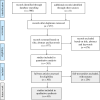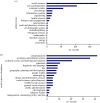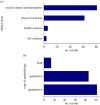Multimodal analysis of disinformation and misinformation
- PMID: 38126058
- PMCID: PMC10731323
- DOI: 10.1098/rsos.230964
Multimodal analysis of disinformation and misinformation
Abstract
The use of disinformation and misinformation campaigns in the media has attracted much attention from academics and policy-makers. Multimodal analysis or the analysis of two or more semiotic systems-language, gestures, images, sounds, among others-in their interrelation and interaction is essential to understanding dis-/misinformation efforts because most human communication goes beyond just words. There is a confluence of many disciplines (e.g. computer science, linguistics, political science, communication studies) that are developing methods and analytical models of multimodal communication. This literature review brings research strands from these disciplines together, providing a map of the multi- and interdisciplinary landscape for multimodal analysis of dis-/misinformation. It records the substantial growth starting from the second quarter of 2020-the start of the COVID-19 epidemic in Western Europe-in the number of studies on multimodal dis-/misinformation coming from the field of computer science. The review examines that category of studies in more detail. Finally, the review identifies gaps in multimodal research on dis-/misinformation and suggests ways to bridge these gaps including future cross-disciplinary research directions. Our review provides scholars from different disciplines working on dis-/misinformation with a much needed bird's-eye view of the rapidly emerging research of multimodal dis-/misinformation.
Keywords: literature review; machine learning; multimodal dis-/misinformation; qualitative analysis.
© 2023 The Authors.
Conflict of interest statement
We declare we have no competing interests.
Figures












Similar articles
-
A scoping review of COVID-19 online mis/disinformation in Black communities.J Glob Health. 2022 Jul 23;12:05026. doi: 10.7189/jogh.12.05026. J Glob Health. 2022. PMID: 35866205 Free PMC article.
-
The Role of Social Media in Health Misinformation and Disinformation During the COVID-19 Pandemic: Bibliometric Analysis.JMIR Infodemiology. 2023 Sep 20;3:e48620. doi: 10.2196/48620. JMIR Infodemiology. 2023. PMID: 37728981 Free PMC article.
-
Meta-perception and misinformation.Curr Opin Psychol. 2023 Dec;54:101717. doi: 10.1016/j.copsyc.2023.101717. Epub 2023 Oct 24. Curr Opin Psychol. 2023. PMID: 37972526 Review.
-
Constituents' Inferences of Local Governments' Goals and the Relationship Between Political Party and Belief in COVID-19 Misinformation: Cross-sectional Survey of Twitter Followers of State Public Health Departments.JMIR Infodemiology. 2022 Feb 10;2(1):e29246. doi: 10.2196/29246. eCollection 2022 Jan-Jun. JMIR Infodemiology. 2022. PMID: 37113808 Free PMC article.
-
Ingraining Polio Vaccine Acceptance through Public Service Advertisements in the Digital Era: The Moderating Role of Misinformation, Disinformation, Fake News, and Religious Fatalism.Vaccines (Basel). 2022 Oct 17;10(10):1733. doi: 10.3390/vaccines10101733. Vaccines (Basel). 2022. PMID: 36298598 Free PMC article.
References
-
- Altay S, Berriche M, Acerbi A. 2023. Misinformation on misinformation: conceptual and methodological challenges. Soc. Media Soc. 9, 1-13.
-
- Pantazi M, Hale S, Klein O. 2021. Social and cognitive aspects of the vulnerability to political misinformation. Pol. Psychol. 42, 267-304. (10.1111/pops.12797) - DOI
-
- Verrall N, Mason D. 2018. The taming of the shrewd. RUSI J. 163, 20-28. (10.1080/03071847.2018.1445169) - DOI
-
- Lewandowsky S, Ecker UK, Cook J. 2017. Beyond misinformation: understanding and coping with the ‘Post-Truth’ Era. J. Appl. Res. Mem. Cogn. 6, 353-369. (10.1016/j.jarmac.2017.07.008) - DOI
Publication types
LinkOut - more resources
Full Text Sources

